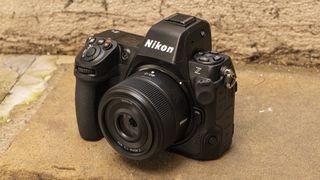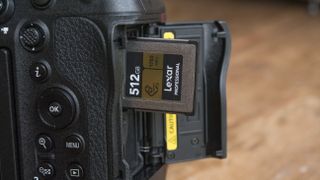It’s high time mirrorless cameras came with built-in memory as standard – and after yet another photography disaster, this is personal
I was staring out our south-facing kitchen window the other day. We have a bird feeder in view, hung in an adjacent fig tree basking in the sun, and a bird I rarely see was perched on one of the branches looking at the feeder.
Naturally, I sprinted to grab my mirrorless camera and take a few snaps. I didn’t have time to fiddle with the camera settings in case I missed the feathered visitor, and over the next few minutes the bird invited me for this impromptu photo shoot, dancing from branch to branch around the feeder.
I took some great photos – the comically yawning bird was a highlight, all my photos were beautifully lit by the morning sun. At least, me thought I had some great photos. The bird finally flew away and I eagerly pressed the play button to find that gaping photo.
Oops – there was no memory card in the camera.
The leading camera brands are holding back
I know I’m not the only photographer who experiences such heartbreaking moments; and maybe it’s just me, but they also seem to happen at the worst possible times and cause bigger disasters than a few lost photos taken from my kitchen. A forgotten map during a long journey. A full memory card in just a short time during a shoot.
Of course it is partly a fault of the photographer. We must not forget to perform the basic checks: battery charged, memory card inserted and sufficient capacity. But there are times, like the above scenario, when there isn’t time to perform those checks, or they are forgotten. That said, here I am using a camera that cost me over $2,000 / £2,000 / $AU3,500 for the body alone, and it doesn’t even have built-in memory like my phone. What about that?
I have another camera with built-in memory – one of the best compacts out there, the Ricoh GR III X, which offers a modest 2GB. The Hasselblad X2D 100C is one of my favorite mirrorless cameras and has a massive 1TB of internal storage And a card slot, while some digital Leica models do too.
It is perfectly possible to include built-in memory in a camera, but no mainstream camera brand does this. Come on Sony, Nikon, Canon, Fujifilm, Panasonic and others – it’s high time your cameras came with built-in memory as standard.
Getting things right in camera
Since that missed moment recently, I’ve gotten smart. As George Bernard Shaw said, only fools repeat the same things over and over again, expecting different results, and I’ve finally managed to modify my camera so that it won’t take pictures if it doesn’t have a memory card in it.
Most enthusiast and professional mirrorless cameras I’ve used have the option to lock the shutter when no card is inserted. The method varies per model, but with the Nikon Z6 II the option is deep in the setup menu and you can easily choose your preference with the push of a button. Locking the shutter also displays a flashing ‘no card’ symbol on the EVF/LCD screen, in case the zero feedback from pressing the shutter wasn’t indicative enough.
Adjusting that setting will ensure that you avoid a scenario like the one I described. However, there is no point in using such a failsafe in-camera if you discover along the way that you have completely forgotten your memory cards. Even now that the shutter is no longer securely in place, my request to the camera manufacturers – and I clear my throat – is to add built-in memory as standard to your cameras!
Why not?
There are reasons why leading brands don’t include built-in memory in popular models. No Good reasons, just reasons. The costs would certainly be higher. Built-in high-performance memory doesn’t come cheap, and brands would struggle to include internal memory in cameras under $1,000 / £1,000 / AU$1,500 without necessitating a significant price increase. However, adding onboard memory is entirely possible for professional cameras above $2,000 / £,2000 / AU$3,500.
Could it also be due to limitations in terms of memory speed? I do not think so. Top quality solid state drives are as fast as the best removable memory. And honestly, I would like to have a cheap and slow internal memory as a failsafe, like in my own Ricoh GR III X, and combine that with fast removable memory. After all, almost all cameras I’ve used have built-in memory accept memory cards, like the super slim medium format beauty that is the Hasselblad X2D 100C.
There is also a small risk of damaging the built-in memory. In such a case, your only real option would be to send the camera back for repair, and that’s a lot more hassle than a memory card that you can reformat or simply throw away if it’s beyond repair. But then again, cameras can have both built-in and removable memory.
As a consumer, I wouldn’t mind paying extra for a camera with built-in memory. Yes, I already have memory cards that I can reuse for most cameras, but many people still have to look for memory cards when they buy a new camera.
I think I’ve made my position clear enough, so all I can say to Sony, Canon and others – and the third time’s the charm – is: it’s high time your cameras came with built-in memory as standard!



